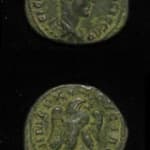Provincial Bronze Sestertius of Emperor Herennius Etruscus, 250 CE - 251 CE
Bronze
C.4041
Obverse: Draped Bust of the Emperor Facing Righ Reverse: An Eagle Standing to the Right, Holding a Wreath in its Beak and Carrying a Palm Frond in its Talon Quintus...
Obverse: Draped Bust of the Emperor Facing Righ
Reverse: An Eagle Standing to the Right, Holding a Wreath in its Beak and Carrying a Palm Frond in its Talon
Quintus Herennius Etruscus Messius Decius was the elder son of Emperor Trajan Decius who ruled from 249-251 A.D. He was appointed to the position of Caesar in the spring of 250 A.D., and was soon thereafter sent to the Danube frontier to coordinate the defenses against the Goths. After participating in a significant defeat of the Goths, Etruscus was raised to the rank of co-Augustus in May of 251 A.D. and ruled alongside his father. The next month, he was killed in battle along with his father, ending his brief reign.
How many hands have touched a coin in your pocket or purse? What eras and lands have the coin traversed on its journey into our possession? As we reach into our pockets to pull out some change, we rarely hesitate to think of who might have touched the coin before us, or where the coin will venture to after it leaves our hands. More than money, coins are a symbol of the state that struck them, of a specific time and location, whether contemporary currencies or artifacts of a long forgotten empire. This stunning hand-struck coin reveals an expertise of craftsmanship and intricate sculptural detail that is often lacking in contemporary machine-made currencies. This ancient coin is a memorial an emperor’s reign passed from the hands of civilization to civilization, from generation to generation that still appears as vibrant today as the day it was struck.
Reverse: An Eagle Standing to the Right, Holding a Wreath in its Beak and Carrying a Palm Frond in its Talon
Quintus Herennius Etruscus Messius Decius was the elder son of Emperor Trajan Decius who ruled from 249-251 A.D. He was appointed to the position of Caesar in the spring of 250 A.D., and was soon thereafter sent to the Danube frontier to coordinate the defenses against the Goths. After participating in a significant defeat of the Goths, Etruscus was raised to the rank of co-Augustus in May of 251 A.D. and ruled alongside his father. The next month, he was killed in battle along with his father, ending his brief reign.
How many hands have touched a coin in your pocket or purse? What eras and lands have the coin traversed on its journey into our possession? As we reach into our pockets to pull out some change, we rarely hesitate to think of who might have touched the coin before us, or where the coin will venture to after it leaves our hands. More than money, coins are a symbol of the state that struck them, of a specific time and location, whether contemporary currencies or artifacts of a long forgotten empire. This stunning hand-struck coin reveals an expertise of craftsmanship and intricate sculptural detail that is often lacking in contemporary machine-made currencies. This ancient coin is a memorial an emperor’s reign passed from the hands of civilization to civilization, from generation to generation that still appears as vibrant today as the day it was struck.



